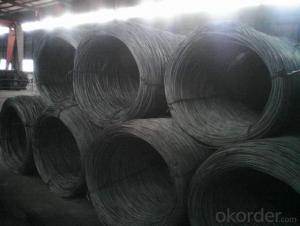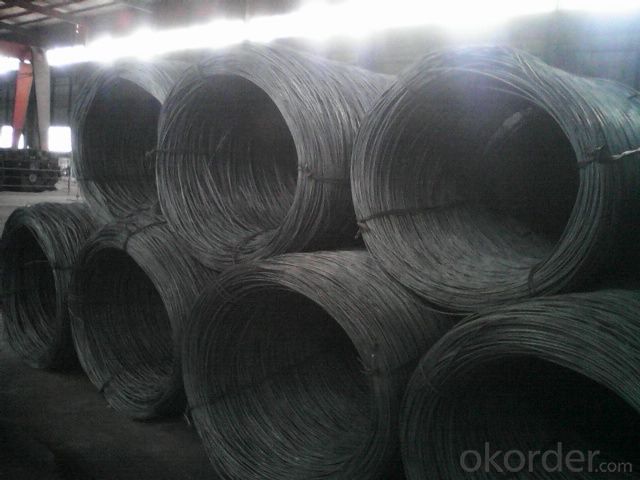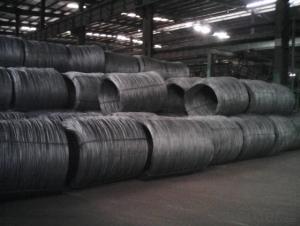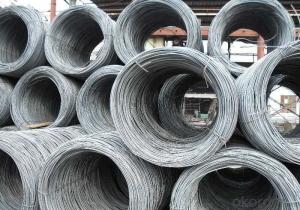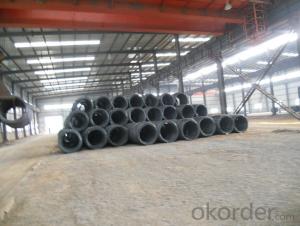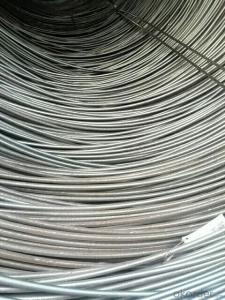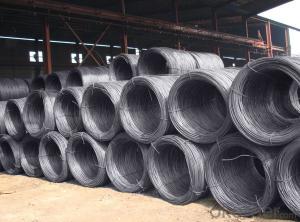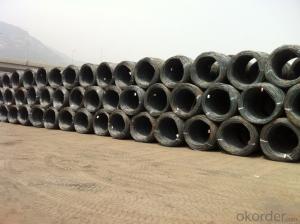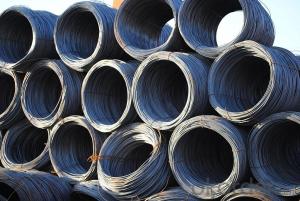Hot Rolled Steel Wire Rod SAE1006-1018 for Making Steel Wire Mesh and Nail
- Loading Port:
- Tianjin
- Payment Terms:
- TT or LC
- Min Order Qty:
- 25 m.t.
- Supply Capability:
- 200000 m.t./month
OKorder Service Pledge
OKorder Financial Service
You Might Also Like
Product Description:
We can offer Hot Rolled Steel Wire Rod SAE1006-1018 for Making Steel Wire Mesh and Nail at great prices with worldwide shipping. Our supplier is a world-class manufacturer of steel, with our products utilized the world over. OKorder annually supplies products to European, North American and Asian markets. We provide quotations within 24 hours of receiving an inquiry and guarantee competitive prices.
Product Applications:
Hot Rolled Steel Wire Rod SAE1006-1018 for Making Steel Wire Mesh and Nail are ideal for structural applications and are widely used in the construction of buildings and bridges, and the manufacturing, petrochemical, and transportation industries. After hot-rolled the products shaped into coil and delivery as finished product, including round, square,rectangular, hexagonal and so on. Since most of the products are round, it is generally called wire rod. Carbon steel wire rod is widely used in construction and manufacturing. Carbon steel wire rod is mainly used for reinforcement of reinforced concrete and welded structure or reprocessed (roberts , nail, etc.) materials, especially used to produce wire drawing, welding electrode, nails, spring, electronic, precise machinery parts and so on.
Product Advantages:
OKorder's Hot Rolled Steel Wire Rod SAE1006-1018 for Making Steel Wire Mesh and Nail are durable, strong, and resist corrosion.
Main Product Features:
· Premium quality
· Prompt delivery & seaworthy packing (30 days after receiving deposit)
· Corrosion resistance
· Can be recycled and reused
· Mill test certification
· Professional Service
· Competitive pricing
Specifications of Hot Rolled Steel Wire Rod SAE1006-1018 for Making Steel Wire Mesh and Nail:
Grade: Q235 Standard: GB
Diameter: 5.5mm, 6.5mm, 7mm, 8mm, 9mm, 10mm, 11mm, 12mm
Alloy or Not: Alloy
Technique: Hot Rolled Place of Origin: China Mainland
Chemical Composition:
Please kindly find our chemistry of our material based on Q235 as below for your reference:
Trademark | Rank | Chemical composition (quality score) % | |||||
C | Si | Mn | S | P | |||
≤ | ≤ | ≤ | |||||
Q235 | A | 0.14-0.22 | 0.30 | 0.30-0.65 | 0.050 | 0.045 | |
Q235 | B | 0.12-0.20 | 0.30 | 0.30-0.70 | 0.045 | 0.045 | |
Trademark | Rank | Pulling Test | |||||
Bend PointΔs/Mpa | Tensile Strength | Elongation Ratioδ5% | |||||
Thickness (Diameter) /MM | Thickness (Diameter) /MM | ||||||
≤16 | 16-40 | ≤16 | 16-40 | ||||
≥ | ≥ | ||||||
Q235 | A | 235 | 225 | 375-500 | 26 | 25 | |
Q235 | B | 235 | 225 | 375-500 | 26 | 25 | |
Packaging & Delivery of Hot Rolled Steel Wire Rod SAE1006-1018 for Making Steel Wire Mesh and Nail:
Packaging Detail: products are packed in coil and then shipped by container or bulk vessel
Each coil weight: About 2.05MT
Delivery Detail: within 45 days after received deposit or LC.
Label: to be specified by customer, generally, each bundle has 1-2 labels
Trade terms: FOB, CFR, CIF
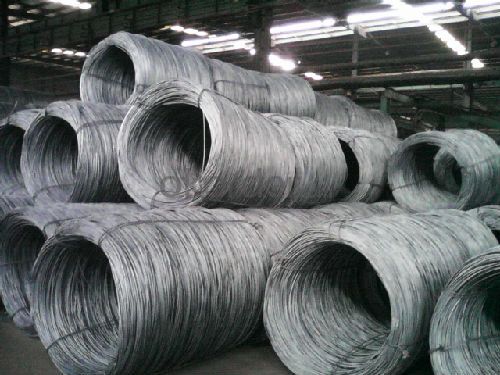
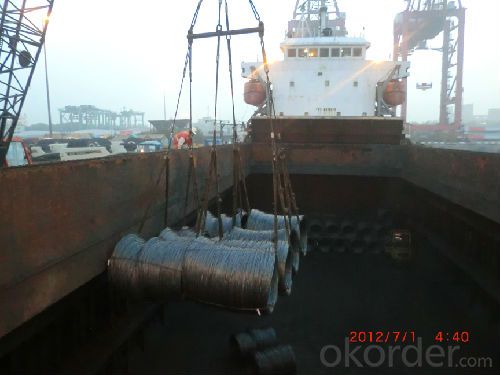
FAQ:
Q1: Why buy Hot Rolled Steel Wire Rod SAE1006-1018 for Making Steel Wire Mesh and Nail from OKorder.com?
A1: All products offered byOKorder.com are carefully selected from China's most reliable manufacturing enterprises. Through its ISO certifications, OKorder.com adheres to the highest standards and a commitment to supply chain safety and customer satisfaction.
Q2: How do we guarantee the quality of our products?
A2: We have established an advanced quality management system which conducts strict quality tests at every step, from raw materials to the final product. At the same time, we provide extensive follow-up service assurances as required.
Q3: How soon can we receive the product after purchase?
A3: Within three days of placing an order, we will begin production. The specific shipping date is dependent upon international and government factors, but is typically 7 to 10 workdays.
- Q: How is steel wire rod packaged for transportation?
- Steel wire rod is typically packaged for transportation by being bundled together and secured with steel strapping or wire ties. The bundles are then stacked on wooden pallets or loaded into steel crates for added protection. Additionally, some manufacturers may opt for further packaging using shrink wrap or plastic covers to safeguard the wire rod from moisture, dust, and other potential damages during transit.
- Q: What are the different types of steel wire rod coatings used for improved heat resistance?
- There are several types of steel wire rod coatings used for improved heat resistance. Some common coatings include zinc-based coatings, aluminum-based coatings, and ceramic coatings. These coatings provide a protective barrier that enhances the wire rod's ability to withstand high temperatures and prevent oxidation or corrosion. Additionally, these coatings can also improve the wire rod's overall durability and longevity in high-temperature environments.
- Q: How is steel wire rod used in the manufacturing of wire rope thimbles?
- Steel wire rod is used in the manufacturing of wire rope thimbles by being shaped and formed into the desired size and shape of the thimble. The wire rod is first drawn through a series of dies to reduce its diameter and increase its strength. It is then bent and molded into the thimble shape, ensuring that it can securely hold the wire rope. Finally, the thimble is heat-treated and galvanized to enhance its durability and resistance to corrosion. Overall, steel wire rod is a crucial raw material in the production of wire rope thimbles, providing the strength and structural integrity necessary for their usage.
- Q: How is steel wire rod used in the manufacturing of wire mesh filters?
- Steel wire rod is used in the manufacturing of wire mesh filters as it serves as the primary material for creating the mesh structure. The wire rod is drawn through a series of dies to reduce its diameter and increase its length, resulting in a thin, continuous wire. This wire is then woven or welded to form the intricate mesh pattern used in wire mesh filters. The strength and durability of steel wire rod make it an ideal choice for these filters, providing reliable filtration capabilities in various industrial applications.
- Q: How is steel wire rod used in the production of wire mesh for erosion control?
- Steel wire rod is an essential component in the production of wire mesh for erosion control. The wire rod is first passed through a series of machines to undergo a process called wire drawing, where it is stretched to a smaller diameter and shaped into a long, continuous wire. This wire is then further processed to achieve the desired thickness and strength required for erosion control applications. In the production of wire mesh for erosion control, the steel wire rod is typically woven or welded together to create a mesh structure. The wire mesh acts as a physical barrier to prevent soil erosion by holding the soil in place, especially on sloping terrain or areas prone to water flow. The wire rod's high tensile strength and durability make it an ideal material for erosion control applications. The wire mesh produced from steel wire rod is capable of withstanding harsh environmental conditions, such as heavy rainfall or strong water currents, without deforming or breaking. The wire mesh can be tailored to specific erosion control needs by adjusting the gauge and spacing of the wires. Thicker wires and smaller spacing are used for applications that require higher strength and stability, such as retaining walls or embankments. On the other hand, thinner wires and wider spacing may be suitable for less demanding erosion control situations, such as stabilizing soil on residential properties or landscaping projects. Overall, the use of steel wire rod in the production of wire mesh for erosion control provides a reliable and long-lasting solution to prevent soil erosion. Its versatility allows for customization based on specific project requirements, ensuring effective erosion control measures are implemented in various applications.
- Q: What are the main factors affecting the water consumption of steel wire rod production?
- The main factors affecting the water consumption of steel wire rod production include the type of production process used, the scale of production, the efficiency of water recycling and treatment systems, and the availability of water resources in the production area. Other factors may include the technology and equipment used, the level of automation, and the overall management practices employed by the steel wire rod production facility.
- Q: How is the ductility of steel wire rod measured?
- The ductility of steel wire rod is typically evaluated using a test referred to as the tensile test, or the tension test. This test involves subjecting a sample of the steel wire rod to gradually increasing tensile forces until it breaks. Throughout the test, the elongation or deformation of the sample is measured, providing an indication of its ductility. During the tensile test, the steel wire rod sample is clamped at both ends, and a force is steadily applied to one end. As the force is applied, the sample begins to stretch, and the amount of stretching is recorded. Typically, this elongation is measured as a percentage of the original length of the sample and is known as the percentage elongation. Moreover, the tensile test also determines the ultimate tensile strength of the steel wire rod. This represents the maximum stress that the sample can endure before fracturing. The ultimate tensile strength is a significant factor for assessing the overall mechanical properties of the steel wire rod. By conducting tensile tests on multiple samples of the steel wire rod, it becomes possible to determine the average ductility of the material. This information is of great importance in various industries that utilize steel wire rod, including construction, automotive, and manufacturing. It enables engineers and designers to comprehend how the material will behave under different loads and conditions.
- Q: What are the different types of steel wire rod surface defects and their repair methods?
- There are several types of steel wire rod surface defects, including scale, pitting, scratches, and cracks. Scale refers to the formation of oxide layers on the surface due to exposure to high temperatures during production. Pitting occurs as small depressions or holes on the surface, often caused by corrosion or impurities in the steel. Scratches are visible marks or grooves on the surface, commonly caused by handling or abrasive contact. Cracks are linear fractures that can occur due to various factors such as stress or improper cooling. To repair these defects, different methods are employed. Scale can be removed through processes like pickling or shot blasting to restore the smoothness of the surface. Pitting can be repaired by grinding or polishing the affected areas to reduce the depth of the pits. Scratches can be minimized through abrasive techniques, such as sanding or buffing, to level the surface. Cracks are more complex to repair and may require welding or heat treatment to restore the integrity of the wire rod. Overall, the repair methods for steel wire rod surface defects depend on the specific type and severity of the defect, with the ultimate goal of achieving a smooth, defect-free surface.
- Q: How is steel wire rod used in the production of wire baskets for storage?
- Steel wire rod is a crucial component in the production of wire baskets for storage. The wire rod is first selected based on its strength, flexibility, and durability, which are essential qualities required for sturdy and long-lasting wire baskets. Once the appropriate steel wire rod is chosen, it undergoes a series of manufacturing processes to transform it into the desired wire basket shape. The rod is first fed through a machine that straightens and cuts it into the desired length. This process ensures uniformity and precision in the wire basket production. The straightened and cut wire rod is then shaped into the desired basket shape using various techniques such as bending, welding, and forming. Bending machines are used to give the wire rod its basket-like structure, while welding processes are employed to join the wire rods together securely. After the wire rod is shaped and welded, it goes through surface treatment processes like cleaning, coating, or galvanizing to enhance its appearance and provide protection against rust and corrosion. The surface treatment also helps in improving the overall durability and longevity of the wire baskets. Finally, the wire baskets are assembled by attaching handles, lids, or dividers, depending on the intended use. This ensures that the wire baskets are functional and convenient for storage purposes. In summary, steel wire rod is a vital material in the production of wire baskets for storage. It provides the necessary strength, flexibility, and longevity required for durable and reliable wire baskets. Through various manufacturing processes, the wire rod is shaped, welded, and treated to create functional and aesthetically pleasing wire baskets suitable for various storage needs.
- Q: How is steel wire rod used in the production of wire for springs in furniture?
- Steel wire rod is a crucial raw material used in the production of wire for springs in furniture. The wire rod is typically made from high-quality steel, which is specifically chosen for its excellent strength and durability. To manufacture wire for springs, the steel wire rod goes through a series of manufacturing processes. Initially, the wire rod is heated and then passed through a series of dies to gradually reduce its diameter. This process is called drawing, and it helps to improve the wire's tensile strength, flexibility, and surface finish. After the wire has been drawn to the desired thickness, it is coiled onto spools and sent to the spring production facility. At the facility, the wire is further processed to create different types of springs used in furniture. For furniture springs, the wire is typically coiled into helical shapes. This coiling process can be done manually or by using specialized machines, depending on the scale of production. The wire's high tensile strength ensures that the springs can withstand the weight and pressure exerted on them when someone sits or lies on the furniture. Once the springs are formed, they are then attached to the furniture frame using various techniques such as tying, stapling, or welding. These springs play a crucial role in providing support and comfort to the furniture, ensuring that users have a comfortable seating or sleeping experience. In conclusion, steel wire rod is essential in the production of wire for springs in furniture. Its excellent strength and durability make it an ideal material for creating high-quality springs that can withstand the demands placed on them. The resulting springs provide the necessary support and comfort for furniture, enhancing the overall user experience.
Send your message to us
Hot Rolled Steel Wire Rod SAE1006-1018 for Making Steel Wire Mesh and Nail
- Loading Port:
- Tianjin
- Payment Terms:
- TT or LC
- Min Order Qty:
- 25 m.t.
- Supply Capability:
- 200000 m.t./month
OKorder Service Pledge
OKorder Financial Service
Similar products
Hot products
Hot Searches
Related keywords
